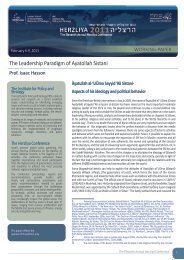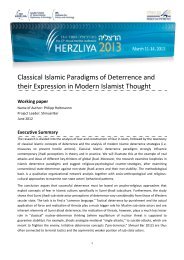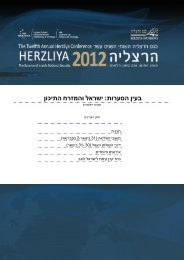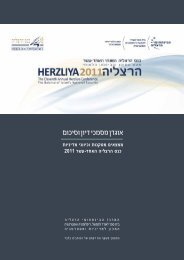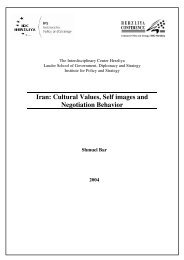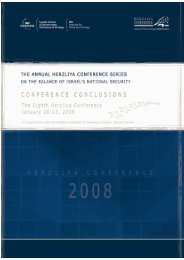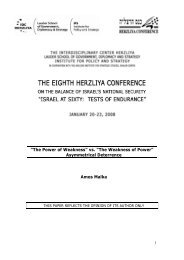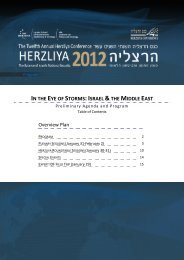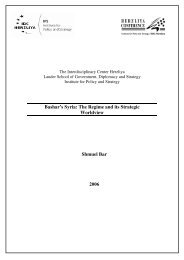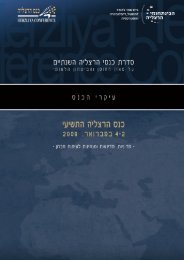The Zawahiri Letter and the Strategy of al-Qaeda
The Zawahiri Letter and the Strategy of al-Qaeda
The Zawahiri Letter and the Strategy of al-Qaeda
Create successful ePaper yourself
Turn your PDF publications into a flip-book with our unique Google optimized e-Paper software.
seem unre<strong>al</strong>istic. For example, Zawihiri’s claim that he misses Zarqawi soundsdisingenuous, as Zarqawi had not been an integr<strong>al</strong> part <strong>of</strong> <strong>al</strong>-<strong>Qaeda</strong> when he was inAfghanistan <strong>and</strong> had refused to send funds back to <strong>al</strong>-<strong>Qaeda</strong> when he was developinghis infrastructure in Europe. Moreover, <strong>the</strong> suggestion that a non-Iraqi should not beleading <strong>the</strong> Iraq insurgency <strong>al</strong>so sounds incompatible with an Islamist ideology thatrejects <strong>al</strong>l forms <strong>of</strong> nation<strong>al</strong>ist identi.cation. More persuasive arguments that <strong>the</strong> letteris Shiite, or Iranian, disinformation are based on a number <strong>of</strong> linguistic usages <strong>and</strong>religious references that seem out <strong>of</strong> place in a Sunni S<strong>al</strong>a. document: (1) <strong>the</strong>reference to <strong>the</strong> son <strong>of</strong> <strong>the</strong> fourth C<strong>al</strong>iph <strong>and</strong> <strong>the</strong> first Shiite Imam, ‘Ali, Hussein bin‘Ali, as “Imam”; (2) <strong>the</strong> blessing <strong>of</strong> <strong>the</strong> Prophet’s family (‘<strong>al</strong>a <strong>al</strong>ihi) in <strong>the</strong> openinggreeting <strong>of</strong> <strong>the</strong> letter; <strong>and</strong> (3) <strong>the</strong> use <strong>of</strong> historic <strong>al</strong>lusions relating to <strong>the</strong> Shia.<strong>The</strong>se arguments do not disprove <strong>the</strong> au<strong>the</strong>nticity <strong>of</strong> <strong>the</strong> document, however, <strong>and</strong>some <strong>of</strong> <strong>the</strong>m are basic<strong>al</strong>ly flawed. <strong>The</strong> cui bono argument that, because <strong>the</strong> documentserves its interest, <strong>the</strong> U.S. administration must have forged it should not be takenseriously; <strong>the</strong> strategy outlined in <strong>the</strong> letter is played out in <strong>the</strong> field in Iraq <strong>and</strong> interrorist attacks in neighboring countries. <strong>The</strong> disowning <strong>of</strong> <strong>the</strong> letter by <strong>al</strong>-<strong>Qaeda</strong> <strong>al</strong>soshould not hold much weight. It would be natur<strong>al</strong> for <strong>the</strong> organization to deny <strong>the</strong>existence <strong>of</strong> disagreements between a senior figure in <strong>al</strong>-<strong>Qaeda</strong> <strong>and</strong> <strong>the</strong> leader <strong>of</strong> <strong>the</strong>organization in <strong>the</strong> most important <strong>the</strong>ater <strong>of</strong> jihad. <strong>The</strong> exposure <strong>of</strong> suchdisagreements would be particularly unwelcome when <strong>the</strong>y concern such a centr<strong>al</strong>operation<strong>al</strong> policy as <strong>the</strong> killing <strong>of</strong> Shia. Because <strong>of</strong> <strong>the</strong> decentr<strong>al</strong>ized nature <strong>of</strong> <strong>the</strong>organization today, moreover, it is <strong>al</strong>so quite possible that its propag<strong>and</strong>a arm <strong>of</strong> <strong>the</strong>organization is not even aware <strong>of</strong> <strong>the</strong>se intern<strong>al</strong> debates <strong>and</strong> reacts on its own tosafeguard <strong>the</strong> image <strong>of</strong> ideologic<strong>al</strong> unity.<strong>The</strong> arguments based on textu<strong>al</strong> an<strong>al</strong>ysis carry greater weight, but still do not tip <strong>the</strong>sc<strong>al</strong>es in favor <strong>of</strong> a forgery verdict. While it is true that “s<strong>al</strong>la Allahu ‘<strong>al</strong>ayhi wa <strong>al</strong>ihiwa s<strong>al</strong>lam” (<strong>the</strong> blessings <strong>and</strong> peace <strong>of</strong> God be upon him <strong>and</strong> his family) is a Shiiteform <strong>of</strong> <strong>the</strong> blessing <strong>of</strong> <strong>the</strong> Prophet—because <strong>of</strong> <strong>the</strong> Shiite adulation <strong>of</strong> <strong>the</strong> household<strong>of</strong> <strong>the</strong> Prophet (ahl <strong>al</strong>-bayt)—<strong>the</strong> form used in <strong>the</strong> letter includes <strong>the</strong> companions <strong>of</strong><strong>the</strong> Prophet (<strong>al</strong>-s<strong>al</strong>ah wa <strong>al</strong>-s<strong>al</strong>am ‘<strong>al</strong>a rasuli’llahi wa a-lihi wa sahbihi), whom aShia would never include. This form is prev<strong>al</strong>ent among Sunnis <strong>and</strong> can be foundabundantly both in books <strong>and</strong> preaching by <strong>al</strong>-Azhar shaykhs <strong>and</strong> even in previousletters by <strong>Zawahiri</strong> himself, <strong>the</strong> au<strong>the</strong>nticity <strong>of</strong> which was not debated. Mention <strong>of</strong>“Imam Hussein” can <strong>al</strong>so be found in many Sunni books—it not unusu<strong>al</strong> ornecessarily indicative <strong>of</strong> a Shia origin. <strong>The</strong> Sunni reference to Hussein as Imam doesnot correspond, <strong>of</strong> course, to <strong>the</strong> Shia concept <strong>of</strong> Imam. Fin<strong>al</strong>ly, <strong>the</strong> g<strong>al</strong>lery <strong>of</strong> historicfigures suggests a Sunni, ra<strong>the</strong>r than Shia, origin. All three are would-be C<strong>al</strong>iphs, <strong>and</strong>Abd<strong>al</strong>lah ibn <strong>al</strong>-Zubayr is considered one <strong>of</strong> <strong>the</strong> archenemies <strong>of</strong> <strong>the</strong> Shia. ‘Abd <strong>al</strong>-Rahman <strong>al</strong>-Ashath was a gener<strong>al</strong> <strong>of</strong> <strong>the</strong> Umayyads who rebelled against <strong>the</strong> C<strong>al</strong>iph‘Abd <strong>al</strong>-M<strong>al</strong>ika in <strong>the</strong> year 81 H <strong>and</strong> succeeded in occupying much <strong>of</strong> Iraq. Hedeclared himself Amir <strong>al</strong>-Mu’minin (Comm<strong>and</strong>er <strong>of</strong> <strong>the</strong> Faithful, C<strong>al</strong>iph), but wasunable to consolidate his rule <strong>and</strong> was eventu<strong>al</strong>ly defeated.Most <strong>of</strong> <strong>the</strong> letter uses typic<strong>al</strong> Wahhabi terminology <strong>and</strong> seems to refer to Zarqawi’sown arguments about <strong>the</strong> Shia (“<strong>the</strong> most evil <strong>of</strong> mankind”) that he made in aFebruary 2004 letter to Zawihiri, <strong>the</strong> au<strong>the</strong>nticity <strong>of</strong> which has not been ch<strong>al</strong>lenged.Certainly, <strong>the</strong> strategy discussed in <strong>the</strong> letter is compatible with au<strong>the</strong>ntic <strong>al</strong>-<strong>Qaeda</strong>thinking regarding <strong>the</strong> short- <strong>and</strong> long-term objectives <strong>of</strong> <strong>the</strong> struggle in Iraq. And a8



